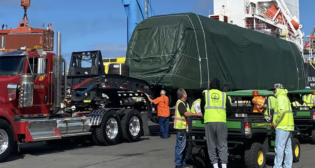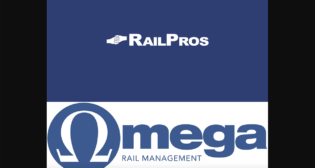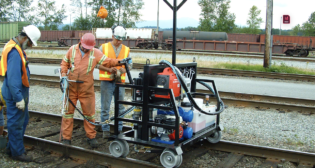
Tie and switch tamping
Written by William C. Vantuono, Editor-in-ChiefAn increase in heavier and more frequent loads is reducing the amount of time allotted for track maintenance. Those same factors also require main-tenance practices, such as tamping, to not just maintain track, but to sustain that maintenance for a longer period of time.
Continuous action, high speeds
Plasser American Corp. has observed an increase in the amount of track maintenance required due to increased axle loads and higher tonnage.
“With traffic at the current levels, track time is a premium. This is why continuous action and multiple tie tamping machines achieving high performance and quality for long lasting track are so important,” says Plasser. “Return on investment on high-speed tamping machine calculations proves that high capacity machines result in a lower cost per foot to maintain.”
The company’s latest designs in tamping machines put an emphasis on higher productivity in the form of multiple tie tamping, versatility, and integrating dynamic track stabilizing into the tamping machine.
The 09-3X-CW Dynamic Tamping Express is a continuous action tamping, lifting, leveling, and lining machine with integrated dynamic track stabilizer, which is capable of tamping concrete or wood ties at the push of a button. Through the integration of the newly developed tamping unit with ATLAS (Automated Tie Locating Analyzing System) and the ATTA (Automated Tamping Tool Adjustment), the 09-3X-CW has the ability to detect tie spacing, position the satellite, and adjust the tamping units and tamping tools to tamp three ties or one tie automatically.
Plasser American says its 09-4X Dynamic Tamping Express brings a new definition of track maintenance speed by offering continuous action, four-tie lifting, leveling, and lining with integrated dynamic track stabilization capable of production rates up to 1.7 miles per hour.
The Unimat 09-32-4S Dynamic, a combination production and switch continuous action tamping machine, has a three-rail lifting device and four-rail tamping, which enables correct tamping of a turnout and carefully handling of rails, ties, and rail fastening systems. The intergraded track stabilizer compacts the ballast and raises the lateral stability.
Other multiple tie tamping machines offered by Plasser are: the 09-32 Dyna-C.A.T. Continuous Action Production and Switch Tamping machine with Integrated Dynamic Track Stabilizer; and 09-2X Continuous Action Tamper.
“The reason for tamping track is to maintain proper track geometry. Tamping combined with lifting, leveling and lining removes existing faults in longitudinal and alignment faults in the track. Tamping eliminates voids under the ties to distribute the load uniformly onto the ties and dispersed into the subsoil,” says Plasser.
Plasser says long-lasting track geometry quality is achieved by non-synchronous squeeze pressure, which results in uniform compacted ballast under the ties.
“This means that each tamping arms squeezes independently to a preset optimal tamping pressure. Another important factor in tamping is the tamping frequency. It has been proven that the ultimate tamping frequency is 35Hz. At this frequency the ballast becomes fluid enough for proper penetration of the tamping tools and still maintain a state where it can be tightly compacted. At frequencies above 35 Hz, the ballast becomes too fluid and difficult to compact. Dynamic track stabilizing combined with tamping helps to exte wnd the maintenance cycles by around 30%, plus it reduces slow orders after tamping,” says Plasser.
Switches are another area the company says requires proper attention when tamping. Plasser’s third-rail lifting device on its heavy-duty switch tampers is synchronized with the main lifts and hoists the turnout rails through the long ties, which reduces the stresses on the ties, rail, and fasteners, and eliminates the need for additional track jacks.
Plasser’s “Split Head” tamping units are individually controlled, with both lateral and vertical adjustment.
“This unique split shift system provides several major advantages over other switch production tampers. Each unit is raised and lowered vertically instead of at an angle, which concentrates ballast compaction near the rail base area where it is most needed,” says Plasser. “Unnecessary tamping at or beyond tie ends or center binding is eliminated. Each individual tamping unit control allows complete switch tamping with a minimum of horizontal tamping unit adjustment, thus reducing the amount of time required to tamp a switch.”
Efficiency, high productivity
“The big thing we hear about all the time is tighter work windows and the total cost of ownership, which ties in to better maintenance planning,” says Allen Branham, product manager surfacing equipment with Harsco Rail.
Increasing productivity is critical to meeting the increasing velocity demands of today’s railroads. For this, Harsco has developed the DRONE Chase Tamper, a truck transportable, unmanned tamper that follows behind a lead machine and tamps those ties the lead machine misses. Any tamper equipped with Harsco’s Jupiter control system is capable of acting as a lead machine to the DRONE.
“The primary purpose is to take a standard production/switch tamper and allow it to become a high production tamper,” says Branham. “You can configure multiple lead machines with the appropriate interconnect hardware to communicate with the DRONE and you can transport your productivity by just moving the DRONE. You also gain redundancy in your fleet in that your production tampers are the same as your switch tampers when we’re talking about the lead machine. It gives railroads the opportunity to have a fleet of production and switch tampers that can also be turned into high production tampers just by adding the DRONE. Because it’s a separate unit, it allows us to deal with the varying track conditions such as poor tie spacing or skewed ties.”
Additional modifications to Harsco’s fleet of tampers include a new PD work head on its Model 6700 Production/Switch Tamper. PD stands for positive displacement and, according to Branham, the new work head will provide better ballast penetration and compaction in a split tool design that uses similar vibrating principles utilized on Harsco’s Mark IV and Mark VI tampers.
“What this has done is allow us to increase productivity. In many cases, we would not need to perform a double tamp, the job is done in a single tamp,” says Branham.
While tamping is needed to maintain proper track geometry, Branham points out that sustaining track geometry is also of interest to the railroads.
“What the railroads are interested in is machines that provide a good track quality and a sustainable track quality, which goes back to proper compaction of the ballast while you’re tamping. Railroads know tamping is necessary, but the better tamping quality, the better compaction, the more sustainable track geometry will be,” says Branham.
Additional tamping trends Branham has noticed include an interest in smaller, more portable tampers that are capable of being transported on trucks instead of along the rails.
Branham says these smaller, lightweight machines are good for spot tamping and moving quickly from site to site.
“We offer a few products to meet these needs. These machines have lifting and lining capability and the ability to record track geometry on a small machine. It’s not as productive, but it’s effective with regards to portability,” says Branham.
Looking further down the road of tamping maintenance, Branham says that Harsco’s DRONE Tamper has opened the doors for additional unmanned equipment, such as the company’s DRONE Anchor Adjuster, which is in the prototype stage.
“All of this is an evolution in our tie finding technology,” says Branham. “Once we perfected our tie finding technology to the point that it was approaching 99.99% accuracy, we were able to develop tampers and an anchor adjuster and we plan to develop other DRONE products, which reduces cost while increasing productivity.”



